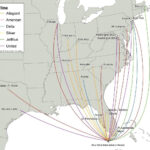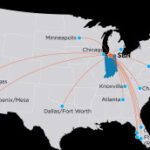Fruit flies got you bugging? Learn How To Stop Fruit Flies Naturally, and reclaim your kitchen with simple, effective DIY solutions! Let flyermedia.net guide you through the best methods for fruit fly control, using ingredients you likely already have. Discover how to create your own fruit fly traps, explore natural repellents, and learn how to prevent infestations for good with eco-friendly strategies, ensuring a pest-free home and a healthier environment. Dive in to find expert tips on organic pest control and sustainable practices to keep your home buzzing with joy, not tiny invaders!
1. What Exactly Are Fruit Flies?
Fruit flies are petite flying insects that are drawn to sweet, ripe fruits and certain vegetables – a preference reflected in their name. They also have a fondness for sugary or fermented liquids like beer, wine, and juice. You’ll often find them congregating around fruit bowls, trash receptacles, and even kitchen drains. Characterized by their small size, roughly equivalent to a grain of rice, they resemble miniature, tan, or brownish houseflies distinguished by their red eyes. Their presence is most noticeable during the summer or late fall, coinciding with the peak season for many fruits.
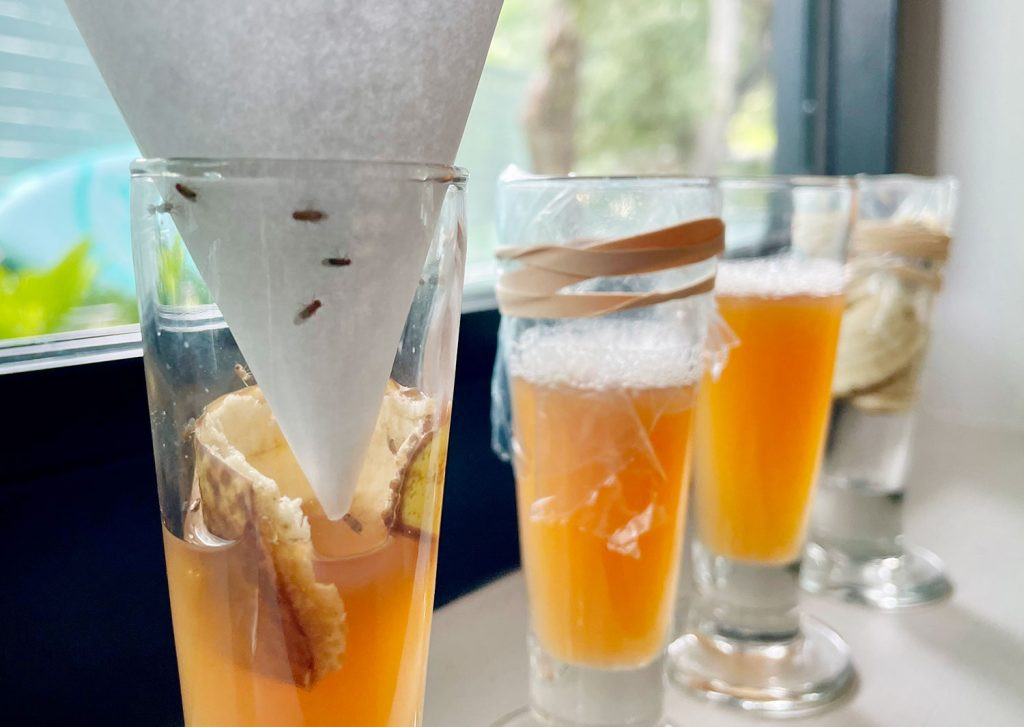 Fruit Flies Trapped In DIY Funnel Trap Method
Fruit Flies Trapped In DIY Funnel Trap Method
The emergence of a fruit fly problem often starts subtly, with just a few individuals sneaking into your home on a piece of fruit. However, the situation can quickly escalate due to the female’s ability to lay hundreds of eggs in a short lifespan, with hatching occurring in as little as 12 hours. These larvae can mature into adults within days, transforming a minor nuisance into a full-blown infestation rapidly. Addressing fruit flies promptly is therefore essential to prevent their numbers from spiraling out of control.
1.1 How Do You Tell Fruit Flies Apart From Fungus Gnats and Drain Flies?
Fruit flies are often confused with other common household pests, especially fungus gnats and drain flies. All are small flying insects, but correctly identifying them will ensure you pick the right way to get rid of them. The easiest way to distinguish them is by where you spot them and what larger insect they resemble.
- Fruit flies look like small flies. They’re found near fruit bowls, trash, or other smelly food sources.
- Drain flies look like small fuzzy moths. They’re typically found near sinks and drains.
- Fungus gnats look like small mosquitos. They’re typically found near houseplants, since they breed in damp soil.
If you’re unsure, you can try one of the traps below and if it attracts the pests in your home, you’ve got fruit flies.
2. What are the Most Effective Natural Methods to Eliminate Fruit Flies?
Effectively managing fruit flies doesn’t require complex solutions or expensive products. The core strategy involves a simple concept: lure the fruit flies into a trap and prevent their escape. Here are several do-it-yourself methods you can try using common household items.
- Funnel Trap
- Plastic Wrap Trap
- Dish Soap Trap
- Rotting Fruit Trap
 4 DIY Fruit Fly Traps Tested On Windowsill
4 DIY Fruit Fly Traps Tested On Windowsill
Some traps might show results faster than others, and it’s important to remember that complete eradication may take several days.
2.1 How to Make a Funnel Fruit Fly Trap?
This trap uses a homemade paper funnel to direct fruit flies into a container. The flies are attracted by the scent inside, but the narrow opening makes it hard for them to get out.
Supplies needed:
- Small clear jar, cup, or container, preferably with a small or narrow opening
- Piece of paper or cardstock
- Tape
- Scissors
- Apple cider vinegar (ACV)
Instructions:
- Select a Container: Choose a small container, like a jar or plastic bottle. A narrow opening helps in trapping the flies.
- Add Apple Cider Vinegar: Pour a bit of apple cider vinegar, old beer, or wine into the container to attract the fruit flies.
- Create a Funnel: Shape a piece of paper into a cone with a tiny hole at the tip. Secure it with tape.
- Place the Funnel: Set the funnel into the container’s opening, ensuring it doesn’t touch the liquid and that there are no gaps for escape.
- (Optional) Outdoor Release: Take the trap outside carefully, remove the funnel, and let the flies escape, if desired.
You can also use a store-bought funnel, but the opening might be too large, allowing the flies to escape.
2.2 How to Make a Plastic Wrap Fruit Fly Trap?
This trap uses apple cider vinegar to attract fruit flies. They go in through small holes in the plastic wrap but struggle to find their way out.
Supplies needed:
- Small clear jar, cup, or container
- Rubber band
- Plastic wrap or plastic bag
- Toothpick
- Apple cider vinegar (ACV)
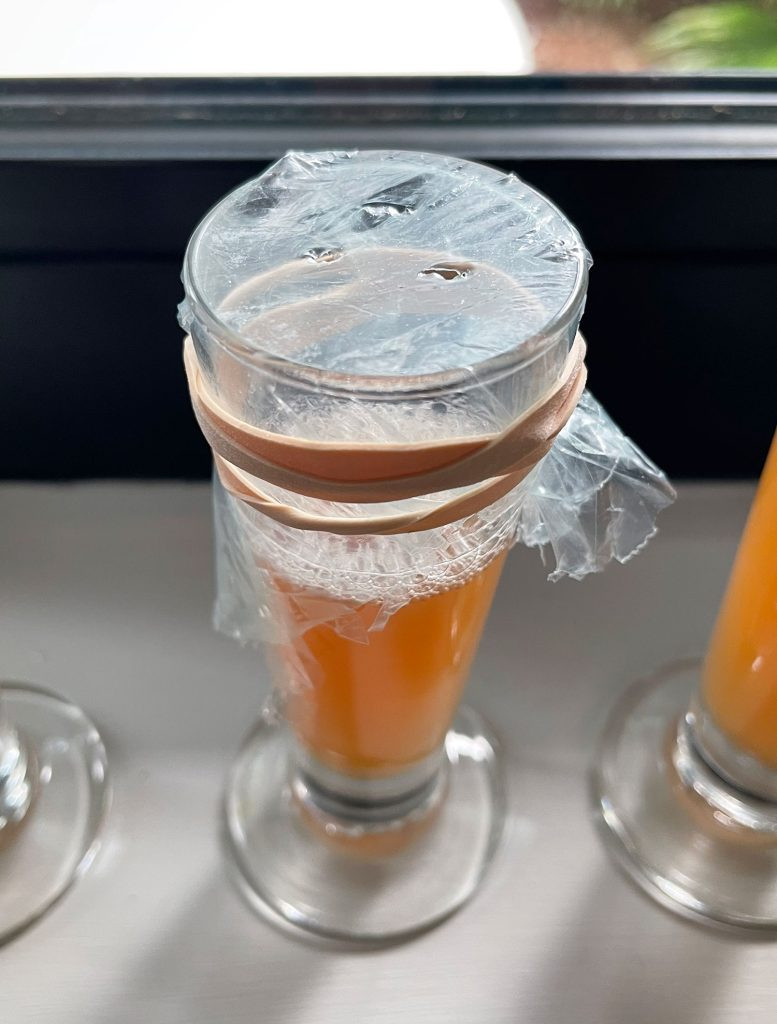 DIY Fruit Fly Trap With Apple Cider Vinegar And Plastic
DIY Fruit Fly Trap With Apple Cider Vinegar And Plastic
Instructions:
- Choose a Container: Select a clear jar or cup.
- Add Apple Cider Vinegar: Pour apple cider vinegar into the container.
- Cover with Plastic: Stretch plastic wrap tightly over the opening and secure it with a rubber band.
- Poke Small Holes: Use a toothpick to make a few small holes for the flies to enter.
- (Optional) Outdoor Release: Carefully take the trap outside, remove the plastic wrap, and let the flies go.
Alternatively, you can puncture holes in a metal jar lid using a hammer and nail.
2.3 How to Make a Dish Soap Fruit Fly Trap?
This trap uses dish soap to prevent fruit flies from escaping, without needing any covers. Note: This method does not allow you to set them free outside, as they get coated in the soap.
Supplies needed:
- Small container, bowl, or dish
- Dish soap
- Apple cider vinegar (ACV)
Instructions:
- Pour Apple Cider Vinegar: Fill the bottom of a container with apple cider vinegar.
- Add Dish Soap: Add a few drops of dish soap to the vinegar and mix gently. The flies will land on the mixture and struggle to fly away.
This method can be combined with the plastic wrap or funnel trap for added effectiveness by adding dish soap to the apple cider vinegar before covering the top.
2.4 How to Make a Rotting Fruit Fly Trap?
For this trap, apple cider vinegar is replaced with fruit, which fruit flies love.
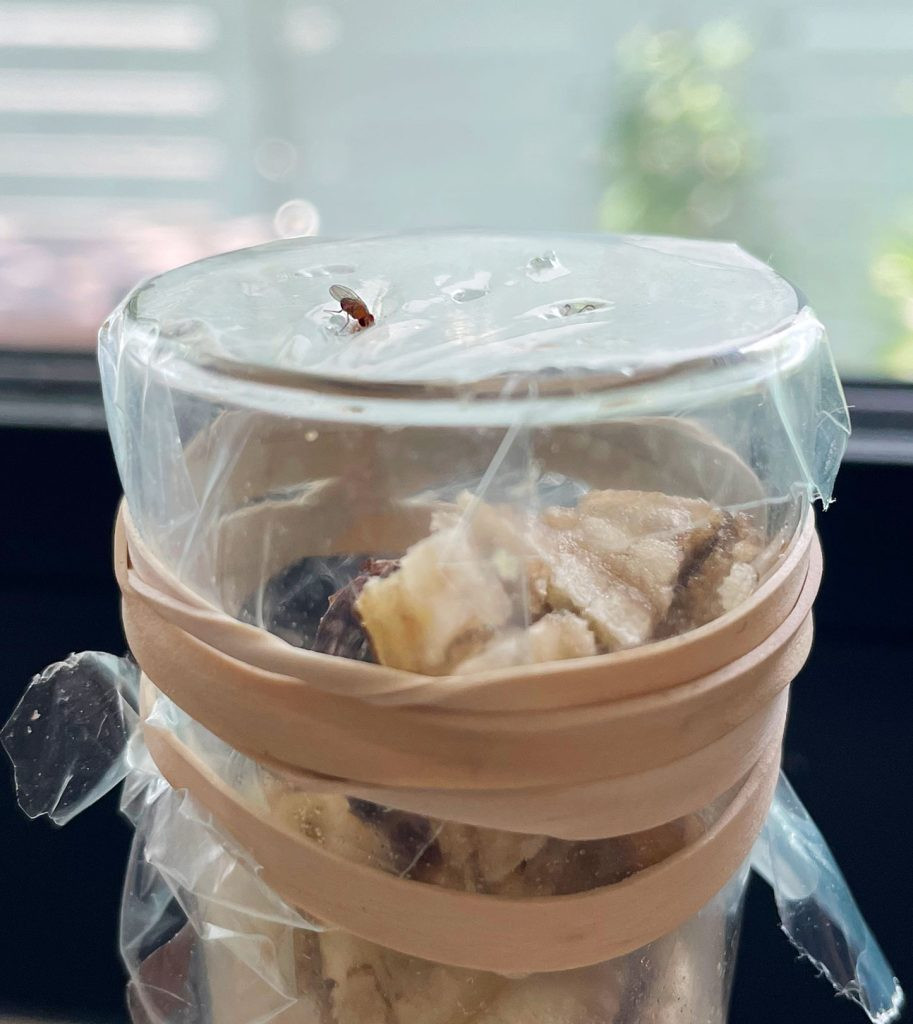 Fruit Fly Entering Plastic Wrap On DIY Trap
Fruit Fly Entering Plastic Wrap On DIY Trap
Supplies needed:
- Small glass jar, cup, or container
- Plastic wrap or paper funnel, depending on your chosen trap mechanism
- A small fruit scrap like a banana peel or apple slice
Instructions:
Substitute apple cider vinegar with a piece of banana peel, apple slice, or peach in either the Plastic Wrap or Funnel trap. Remember to replace the fruit every day or two to avoid unwanted smells.
3. Which Fruit Fly Trap is The Most Effective?
The effectiveness of a fruit fly trap often depends on the bait used. Traps with banana peel have shown to perform better than those using only apple cider vinegar. For example, two Plastic Wrap Traps set up with different lures showed that the one with banana peel significantly outperformed the one with apple cider vinegar and soap.
So, regardless of the trap style, adding a piece of fruit can greatly increase its success. The plastic wrap trap is also favored for its ease of assembly and stability.
4. What Type of Bait Attracts Fruit Flies the Best?
Using fruit scraps in traps is highly effective. To determine which fruit works best, a test was conducted using banana peel, apple slices, and a strawberry in separate Plastic Wrap Traps over 24 hours.
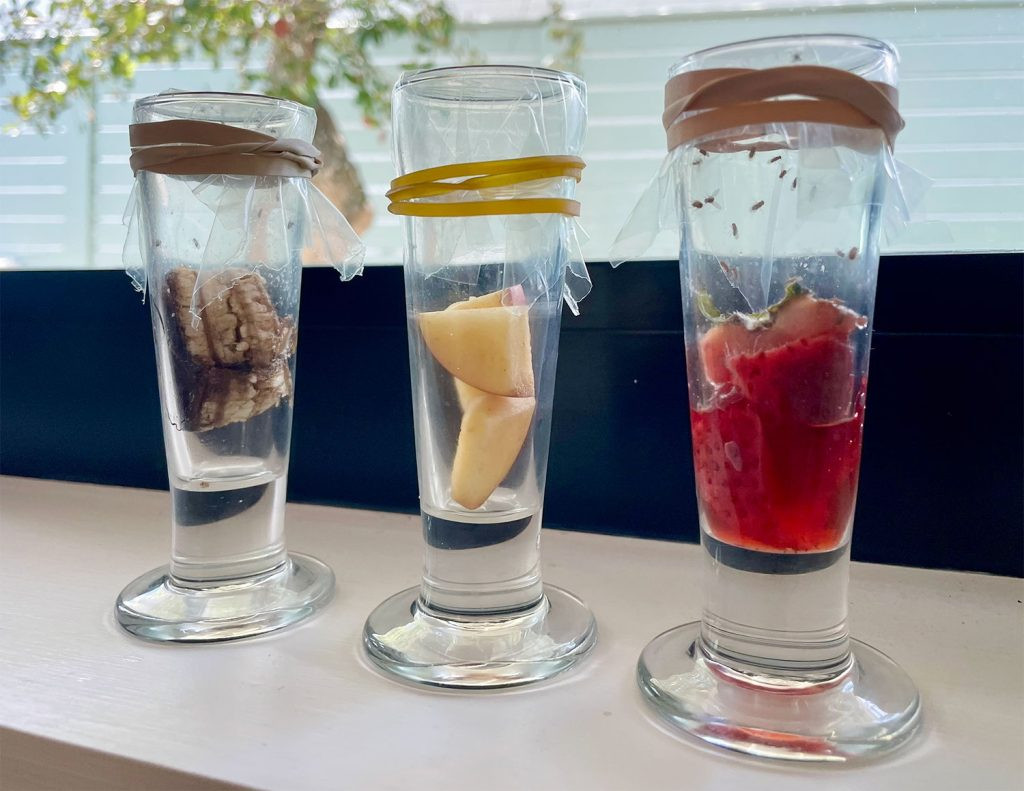 Fruit Fly Traps With Different Rotten Fruit Baits
Fruit Fly Traps With Different Rotten Fruit Baits
The strawberry attracted the most fruit flies, especially as it started to rot. Banana peel also worked well, while apple slices were ineffective.
5. What are Some Natural Fruit Fly Repellents?
Besides traps, several natural substances can repel fruit flies. These include essential oils and herbs that interfere with their sensory perception.
5.1 What Essential Oils Repel Fruit Flies?
Essential oils like eucalyptus, peppermint, and lemongrass are known to deter fruit flies. These oils possess strong scents that disrupt the flies’ ability to locate food sources.
How to Use Essential Oils:
- Diffusers: Add a few drops of essential oil to a diffuser to spread the scent throughout your kitchen.
- Sprays: Mix essential oils with water in a spray bottle and apply around areas prone to fruit flies.
- Cotton Balls: Soak cotton balls in essential oil and place them in strategic locations, such as near fruit bowls or trash cans.
5.2 What Herbs Repel Fruit Flies?
Certain herbs also work effectively as natural repellents. Basil, lavender, and bay leaves are particularly useful in keeping fruit flies away.
How to Use Herbs:
- Fresh Herbs: Place pots of basil or lavender on your kitchen counters.
- Dried Herbs: Scatter dried bay leaves around your fruit bowl or in areas where fruit flies are common.
- Herb Sachets: Create sachets filled with dried herbs and hang them in your pantry or near fruit storage areas.
6. How Effective are Store-Bought Fruit Fly Traps?
If DIY methods aren’t effective or convenient, store-bought traps are available. These traps often have positive reviews and cost less than $20. They are particularly useful if you need to catch other flying insects or prefer a more discreet trap.
During an experiment comparing homemade and store-bought traps, a Terro Trap was tested against banana and strawberry traps.
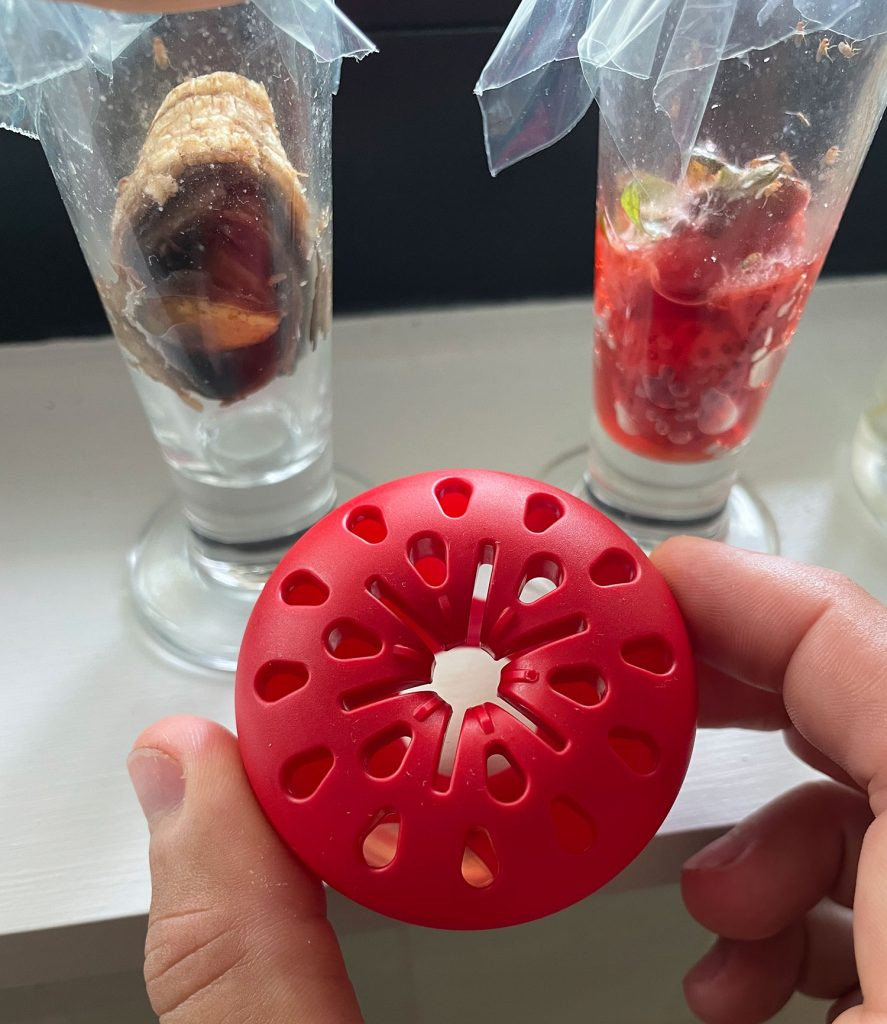 Terro Fruit Fly Apple Trap With No Fruit Flies In It
Terro Fruit Fly Apple Trap With No Fruit Flies In It
Initially, the homemade traps outperformed the store-bought one. However, after removing the DIY traps, the store-bought trap caught a significant number of flies. This suggests that while homemade traps may work faster, store-bought traps are effective over time, especially if you want something more discreet.
7. How to Stop Fruit Flies Naturally by Preventing Them?
Preventing fruit flies from infesting your home is the best approach. Here are some simple steps you can take:
- Clean Kitchen Surfaces: Wipe down counters, stovetops, tables, and any surfaces that might have food residue or spills. Fruit flies are attracted to fruit, sweet juices, and alcohol.
- Take Out Your Trash: Food scraps in your garbage can quickly become a breeding ground for fruit flies.
- Dispose of Overripe Fruit: Check your fruit bowl for rotting fruit and dispose of it before it becomes a problem.
- Wash Your Fruit as Soon as You Get It Home: Washing produce can remove eggs or larvae that might be present (except for berries, which can rot faster from moisture).
- Store Produce in the Fridge When Possible: Fruit flies do not thrive in cold temperatures.
- Clean Your Sink Drain: Food scraps in your drain can attract fruit flies. Use your garbage disposal and flush the drain regularly.
8. What Role Does Hygiene Play in Preventing Fruit Flies?
Maintaining good hygiene is crucial in preventing fruit fly infestations. Regularly cleaning surfaces, disposing of waste, and washing produce can significantly reduce the risk of attracting these pests.
8.1 How Often Should I Clean My Kitchen to Prevent Fruit Flies?
Daily cleaning is recommended to prevent fruit flies. This includes wiping down counters, sweeping floors, and cleaning up any spills immediately.
Cleaning Checklist:
- Wipe down counters after each meal.
- Sweep or mop the floor daily.
- Clean up spills as soon as they happen.
- Empty trash cans regularly.
8.2 How Should I Store Fruits and Vegetables to Prevent Fruit Flies?
Proper storage can minimize the chances of fruit flies infesting your produce. Here are some tips:
- Refrigeration: Store fruits and vegetables in the refrigerator to slow down ripening and reduce the attraction to fruit flies.
- Sealed Containers: Use airtight containers to store produce that must be kept at room temperature.
- Avoid Overcrowding: Don’t overcrowd your fruit bowl. Overripe fruit can attract flies quickly.
9. What Environmental Factors Contribute to Fruit Fly Infestations?
Certain environmental conditions can make your home more susceptible to fruit fly infestations. Understanding these factors can help you take proactive measures.
9.1 How Does Temperature Affect Fruit Fly Infestations?
Fruit flies thrive in warm temperatures. Warmer conditions accelerate their life cycle, leading to faster reproduction and higher population densities.
Strategies for Temperature Control:
- Air Conditioning: Use air conditioning to keep your home cooler, especially during summer months.
- Ventilation: Ensure good ventilation to prevent moisture buildup, which can attract fruit flies.
- Avoid Overheating: Be cautious about overheating your kitchen while cooking, as this can create a favorable environment for fruit flies.
9.2 How Does Humidity Affect Fruit Fly Infestations?
High humidity can also contribute to fruit fly infestations by creating a moist environment that favors their development.
Strategies for Humidity Control:
- Dehumidifiers: Use dehumidifiers to lower the humidity levels in your home.
- Proper Ventilation: Ensure adequate ventilation in kitchens and bathrooms to reduce moisture.
- Fix Leaks: Repair any leaks in plumbing to prevent water from accumulating and attracting pests.
10. How Can I Protect My Business From Fruit Flies?
Fruit flies aren’t just a problem for homeowners. Businesses like restaurants and grocery stores can suffer significant losses due to fruit fly infestations. Here are some steps to protect your business:
10.1 What are the Best Practices for Commercial Fruit Fly Control?
Commercial settings require more rigorous pest control measures. Here are some best practices:
- Professional Pest Control: Hire a professional pest control service to conduct regular inspections and treatments.
- Employee Training: Train employees on proper sanitation practices, including cleaning procedures and waste disposal.
- Regular Inspections: Conduct regular inspections of storage areas, drains, and other potential breeding grounds.
10.2 How Can I Prevent Fruit Flies in My Restaurant?
Restaurants are particularly vulnerable to fruit fly infestations. Here are some specific prevention measures:
- Daily Cleaning: Implement a strict daily cleaning schedule, focusing on areas where food is prepared and stored.
- Proper Waste Disposal: Ensure that all waste is disposed of properly and that trash cans are cleaned regularly.
- Drain Maintenance: Regularly clean and flush drains to prevent buildup of organic matter.
FAQ: How to Stop Fruit Flies Naturally
Here are some frequently asked questions about how to stop fruit flies naturally:
1. What attracts fruit flies the most?
Ripe and rotting fruits and vegetables, as well as sugary and fermented liquids, are major attractants.
2. How quickly can a fruit fly infestation occur?
A few fruit flies can turn into a large infestation in a matter of days due to their rapid breeding cycle.
3. Are fruit flies harmful to humans?
Fruit flies are generally harmless, but they can contaminate food and spread bacteria.
4. Can fruit flies breed in drains?
Yes, fruit flies can breed in drains where organic matter accumulates.
5. Will fruit flies go away on their own?
Fruit flies will not go away on their own unless their food source is eliminated.
6. Is apple cider vinegar the best bait for fruit flies?
Apple cider vinegar is effective, but rotting fruit like strawberries and bananas often works even better.
7. How often should I empty fruit fly traps?
Empty traps regularly, ideally every day or two, to maintain their effectiveness.
8. Can I use bleach to get rid of fruit flies in drains?
While bleach might kill some flies, it’s not the most effective solution and can be harmful. Use enzymatic drain cleaners instead.
9. Are there any plants that repel fruit flies?
Yes, basil, lavender, and bay leaves are known to repel fruit flies.
10. How can I tell if I have a fruit fly infestation?
You’ll typically see small flies buzzing around fruit bowls, trash cans, and other food sources.
Don’t panic when you spot fruit flies! Act quickly using the easy, effective, and fast-acting solutions described here. Learn more about pest control and other valuable tips by visiting flyermedia.net today!
This article is designed to provide you with actionable strategies and helpful information, making it easier than ever to manage and prevent fruit flies in your home.
